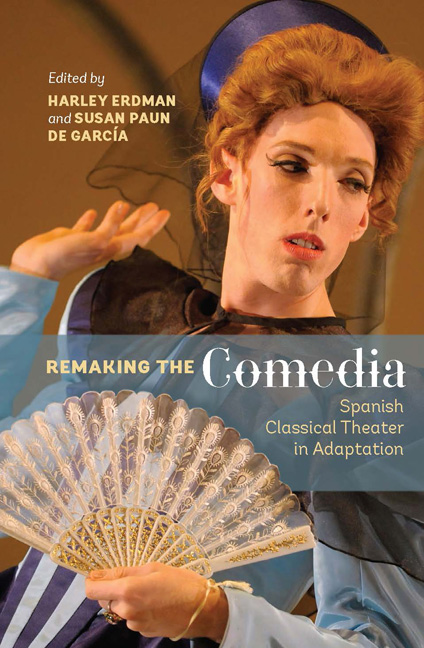Book contents
- Frontmatter
- Contents
- Illustrations
- Contributors
- Preface
- Note to the Reader
- Acknowledgements
- PART I THEORIZING
- PART II SURVEYING
- PART III SPOTLIGHTING
- PART IV SHIFTING
- 21 Porous Boundaries: novela or comedia?
- 22 Lope de Vega and Lenfilm: The Dog in the Manger's Cross-Cultural Journey
- 23 Classical Theater and Puppetry: La Máquina Real
- 24 Remaking Moreto's El desdén con el desdén: From Author's Text to Director's Text
- 25 Lope's Peribáñez on the Lyric Stage
- 26 A Musical Marta
- Play Titles Cited
- Works Cited
- Index
23 - Classical Theater and Puppetry: La Máquina Real
from PART IV - SHIFTING
Published online by Cambridge University Press: 05 December 2015
- Frontmatter
- Contents
- Illustrations
- Contributors
- Preface
- Note to the Reader
- Acknowledgements
- PART I THEORIZING
- PART II SURVEYING
- PART III SPOTLIGHTING
- PART IV SHIFTING
- 21 Porous Boundaries: novela or comedia?
- 22 Lope de Vega and Lenfilm: The Dog in the Manger's Cross-Cultural Journey
- 23 Classical Theater and Puppetry: La Máquina Real
- 24 Remaking Moreto's El desdén con el desdén: From Author's Text to Director's Text
- 25 Lope's Peribáñez on the Lyric Stage
- 26 A Musical Marta
- Play Titles Cited
- Works Cited
- Index
Summary
Despite the considerable bibliography generated in recent years about the staging of our classical texts, and despite John E. Vareyí0027;s Historia de los títeres en España (1957), the marionette theater of the Spanish Golden Age has been of little interest to critics and even less to theater professionals. Scholarly studies have been few and far between. Perhaps for this reason, no company has dared to approach in a rigorous way the puppet theater of Spain's “teatro áureo.”
Just a few years ago, Francisco J. Cornejo of the University of Seville started to revise the documents Varey had gathered in his monograph; deepening the work done by the English Hispanist, he has shed more light on the history of what in earlier times was called máquina real (13–33). Reclaiming this term and using Cornejo's research as a launching pad, the Cuenca-based puppeteer Jesús Caballero has chosen to render homage to his Castilian predecessors by founding a company with the name La Máquina Real. This company gathers together a group of theater specialists passionately dedicated to both Baroque stagecraft and theatrical archeology.
As Varey explains, the name “máquina real” appeared in the middle of the seventeenth century to refer to companies of puppeteers and acrobats (“volatines”) who performed in corrales. The word “máquina” was used at the time to refer to miniature theaters of hand-controlled figurines or “totilimundis.” The adjective “real” could have had some connection with the need to obtain an official performance license, in much the same way that the prestigious companies that were “de título” [titled] were distinguished from their poor relatives, the “de la legua” [traveling] players; or it could well be that some of these groups performed for the king, or that there was a similarity between the original miniature puppet theaters and the new technologies that Italian scenographers were introducing into court performances at the Coliseo del Buen Retiro (Cornejo 17–20).
We do know that the old máquina real companies would work in the corrales during Lent, taking advantage of the prohibition that kept flesh-and-blood performers off the stages between Ash Wednesday and Easter Sunday.
- Type
- Chapter
- Information
- Remaking the ComediaSpanish Classical Theater in Adaptation, pp. 229 - 236Publisher: Boydell & BrewerPrint publication year: 2015



